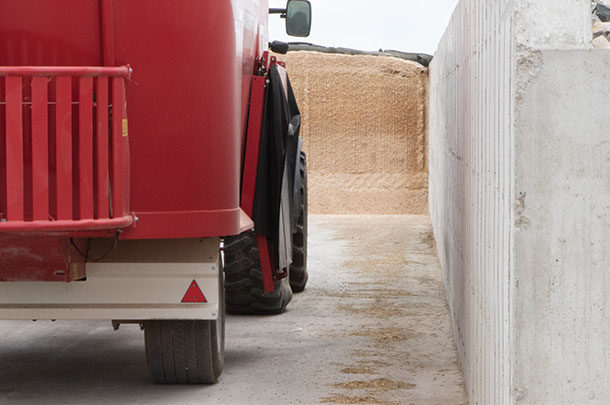It is important to consider all potential hazards when working around a bunker silo. Some of the greatest risks include being crushed under falling silage and falling from on top of the silage pile.
Filling the bunker silo
Before you begin filling a bunker silo, it is imperative that you inspect the structure thoroughly for damage. Look for cracks and ensure they are repaired before you begin filling.
There is often a team of people needed to fill a bunker silo – ensure that everyone who is part of this team talks about a plan first and discusses who will be doing each task. Ensure that each person involved has been trained on their assigned task. Ensure that others who are not involved, including other employees, contractors, children and animals, stay out of the area.
Before you begin, re-inspect the bunker silo for damage. Also conduct a pre-use inspection on all equipment that will be used, which includes testing that the backup alarms are in working order. When packing, use a 1-to-3 slope ratio, which is 1 foot high for 3 feet of length. Also ensure that you do not pile the silage higher than the equipment you have for feedout.
Covering and removing plastic and tires
Falls and avalanches can occur when removing the tires and plastic from the top of the silage. Never stand close to the front face or directly on the silage. When removing tires or cutting plastic, stand behind the area you will be cutting and remain on the portion of the bunker still covered by plastic. When you are working at a height greater than 10 feet, you are required by law to wear fall protection. You must also have a policy and procedure for working at heights as well as the proper training for all employees doing this task. Use caution when on the silage pile, as plastic covers can be slippery and may be covered with ice, snow, water or mud. Wear appropriate slip-resistant footwear to help decrease the risk of slips, trips and falls. When laying or removing tires and other weights, use safe lifting techniques.
Avalanche zone
It is important to establish an avalanche zone on the ground and on top of the silage. The measurements of this area will vary based on the height and conditions of the silage, as well as the type of silage. The avalanche zone is the immediate area in front and on top of the front face of the bunker silo. This is the highest-risk area if a silage avalanche occurs.
Removing silage from the bunker silo
There are a few things you should do before you begin taking feed from the bunker silo. To start, ensure the area is clear of other equipment, people, animals and children. Just because someone can see you in the tractor does not mean you can see them. Also, inspect the equipment you will be using and the silo itself. Look for any soft spots or if there is an area with overhang in the pile and choose where you will take from the pile. Use equipment with an enclosed cab, a working seatbelt and anti-roll technology. Ensure that you do not undercut during the removal process. Undercutting occurs when silage is taken from the bottom of the pile, resulting in an overhang of silage that is incredibly unstable, as there is nothing under it to support its weight. To avoid undercutting, ensure your equipment can reach the top of the silage pile or use a silage defacer.
Inspection and sampling
When taking a sample, scoop up some silage with the loader, drive the loader away from the avalanche zone and then get out of the loader and take your sample. Do not take a sample from the silage face while standing in the avalanche zone. Do not get out of the loader to do sampling while still inside the avalanche zone. Never allow a person to ride in the bucket of a front-end loader to take samples.
Gases
Gases from the silage can be very toxic. Gases can get trapped under the plastic cover, so be careful when you are removing plastic. Gases are heavier than air, so they can be found in larger quantities at the bottom of a silage pile. Be aware of this when working around bunker silos. If someone is exposed to silo gases, move them away from the bunker silo where there is fresh air if it is safe to do so and call for medical attention immediately.
Training
Finally, one of the most important aspects of bunker silo safety is training. Training is not only a preventative way to ensure employees do not get injured, but it also ensures employees know what they are doing and the job gets done right and safely the first time. Employees, regardless if they do work on the bunker silo or not, should receive training about the hazards involved with working around bunker silos. For employees who are filling the silo, covering it, taking samples or doing the feedout, they need further training. In addition to knowing about the hazards and risks of this job, they should also receive instructions on how to do each one of these tasks properly and safely.
Finally, each employee should do a practical evaluation with their manager to ensure they have gone through each of the tasks and were able to do them safely and correctly. All of this training must be documented, and the records must be retained in the employee’s training record.










